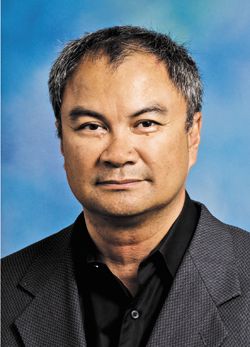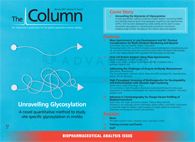Unravelling the Mysteries of Glycosylation
A novel quantitative method combining multiple reaction monitoring (MRM) and ultrahigh‑pressure liquid chromatography coupled to mass spectrometry (UHPLC–MS) has been developed by Carlito Lebrilla and his team to study site-specific glycosylation in manufactured recombinant monoclonal antibody drugs (rmAbs). He spoke to The Column about this research.
Photo Credit: Marie Maerz/Shutterstock.com

A novel quantitative method combining multiple reaction monitoring (MRM) and ultrahighâpressure liquid chromatography coupled to mass spectrometry (UHPLC–MS) has been developed by Carlito Lebrilla and his team to study site-specific glycosylation in manufactured recombinant monoclonal antibody drugs (rmAbs). He spoke to The Column about this research.- Interview by Alasdair Matheson
Q. What are recombinant monoclonal antibody drugs and why are they effective as biopharmaceuticals?
A: Recombinant monoclonal antibody (rmAbs) drugs are part of the large current wave of therapeutics that are protein based and typically based on immunoglobulins. They are commonly used in medicine to bind and neutralize antigens present on cell membranes.
These compounds are typically expressed in Chinese hamster ovary cells, but they can be expressed in other cells or, more generally, bacteria and yeast. Being based commonly on immunoglobulin G (IgG), and specifically IgG1, they are glycosylated and are engineered so that they are glycosylated on only one site.
Q. What therapies are they used in?
A: They are used in therapies for a large variety of diseases, including many types of cancer, autoimmune diseases, infectious diseases, and even for lowering cholesterol. The number of therapeutic applications will only get bigger, and there are currently large number of clinical trials underway involving rMAbs.
Q. Why is glycosylation an important process to study?
A: Glycans are post-translational modifications of proteins and are present in therapeutic antibodies. They are very complicated and are found in various forms to yield a wide diversity to the protein glycoforms-essentially proteins with the same peptide backbone but different glycan structures. A single protein with a single site of glycosylation can have over 100 glycoforms. Glycans are an important component of proteins and determine their functions and how the proteins interact with the immune system. Some glycoforms are pro-inflammatory, while others are anti-inflammatory. Other glycoforms may increase the circulating half-life of the proteins, while others may simply be involved in maintaining the active structural features of the proteins.
In the production of the therapeutics, glycosylation is the most difficult to control. The glycoproteins generally use the host cell glycosylation during production, however, the production environment can significantly alter the glycosylation. Even fine changes in glycosylation can alter the protein functions. It is therefore important to monitor glycan expression during production.
Q. You recently worked on a project to quantitate site-specific glycosylation in manufactured recombinant monoclonal antibody drugs (1). What was the aim of this research?
A: The goal of the project was to simplify the analysis while monitoring the glycan structures over a large dynamic range. The current method is to release the glycans, label them, and analyze them by capillary electrophoresis (CE) or liquid chromatography (LC). This method only identifies a small number of glycoforms, and is not specific to the proteins. Glycoprotein impurities that are part of the manufacturing process can interfere in this type of analysis. Therefore, protein isolation must first be performed to yield a specific analysis. We wanted to develop a method that required little or no protein isolation or enrichment that can be used directly in the production process. A problem with isolation and enrichment is that they require processes that may favour one set of glycoforms over another. Therefore, any process to isolate or enrich the protein may bias the glycan analysis. By digesting the protein in situ and analyzing the glycopeptide without too much sample preparation, we obtain the most native glycan distribution.
Q. Why is this type of characterization important?
A: The characterization of therapeutics is a requirement of the FDA and other regulatory agencies. Small molecule drugs can be fully characterized by various analytical methods that yield molecular composition and specific spatial arrangements of the atoms. With proteinâbased drugs there is no single structure. The structural heterogeneity has required different approaches and thinking. With biologics, such as rMAbs, this has been a challenge and the characterization requirement is still changing. However, a new issue is that the patents of some of these drugs are now ending. Biosimilars-drugs made from the same protein with variations typically in the post-translational modification-are starting to compete with the original licensed drug. The characterization of these drugs and how they compare to the original is becoming an issue. Glycosylation directly affects the efficacy of the drug by increasing the circulating half-life, by retaining the conformation, and by specifically targeting tumours. Maintaining or even improving the glycosylation will be an important component of the biosimilar efforts as manufacturers try to avoid new clinical trials for new forms of the drugs.
Q. You chose multiple reaction monitoring (MRM) on an ultrahighâpressure liquid chromatography−triple quadrupole MS (UHPLC–QqQ-MS) system. Why did you choose this approach and what are the advantages compared to traditional methods?
A: In this method, rather than release the glycans, we digested the proteins using protease, leaving the glycopeptide intact. We characterized the fragmentation of this glycopeptide using collision-induced dissociation (CID). Once we determined the fragmentation behaviour of the glycopeptide, we used MRM to quantitate the glycopeptide. UHPLC yielded a significantly faster run time compared to conventional high performance liquid chromatography (HPLC). This has the significant advantage of not having to isolate the glycoprotein. The glycopeptides yield both the glycan and protein information. The high sensitivity of MRM is then coupled to the high specificity using glycopeptides.
This method works because we have previously characterized the glycans produced with each protein in various cell lines. A more nontargeted approach would be more useful, but there are limitations with obtaining a simple peptide profile of the protein. One major issue is that glycosylation severely attenuates the peptide ion abundances. A glycopeptide compared to its nonglycosylated version can have a 10-fold decrease in ion abundances for the same concentration. This is compounded by the fact that a glycopeptide’s ion abundance is further attenuated in a sea of peptides that are more effective at obtaining protons, which is necessary for ionization.
Q. What were the main analytical challenges you encountered and how did you overcome them?
A: The main analytical challenge was the use of MRM on glycopeptides. Before this work, there were very few examples of MRM with glycopeptides (2). It was believed that the fragmentation was not sufficiently unique to identify the glycopeptide. However, we found that the chromatographic retention times were sufficiently unique. This information, the mass, and the fragments unique to glycan moieties were sufficient to identify and quantify the glycopeptide. We are currently developing MRM transitions for a large host of human glycopeptides. We believe this will have great value in therapeutics and biomarker discovery.
MRM can also be used to quantify other complicated compounds, including free oligosaccharides and glycolipids. Although these compounds have previously not been typically probed by MRM, recent reports show that they work well (3). MRM can be incorporated in methods for quantifying compounds that are commonly thought “too difficult” to analyze.
Q. What were your main findings?
A: This method is highly sensitive, highly specific, and is remarkably simple for monitoring glycan on specific proteins. We are now using this same method to monitor glycosylation in specific proteins in various human, animal, and plant tissues.
Q. Do you have any advice for scientists investigating glycosylation?
A: Glycosylation has been ignored analytically in the past because it was believed to be too difficult. There was a misconception that there is such a wide variation in structures and compositions that it would be too difficult to try to characterize them all. However, in a specific biological system, we find that the numbers are actually limited to the point that they can all be characterized and monitored using today’s advanced analytical methods. In our group, we have developed annotated libraries of, for example, serum glycans so that we can identify compounds readily. I think progress in individual areas will require deep characterization of tissue-specific glycomes.
Q. What are you working on next?
A: Our group has had a long interest in observing and monitoring protein glycosylation. We are currently using this method to explore glycosylation in human tissues, including serum, human milk, and the brain. Glycosylation of proteins in human and animal tissues are still not well characterized. We hope to use this and other methods to obtain glycan patterns for diseases and health.
I also feel that MRM is still underutilized in glycomics research. We are currently pushing the boundary of MRM in glycomics by determining how many proteins and sites of glycosylations in tissue can be obtained and quantitatively monitored.
References
- N. Yang et al., Anal. Chem. 88(14), 7091–7100 (2016).
- L.R. Ruhaak et al., J. Proteome Res. 15, 1002–1010 (2016)
- G. Xu et al., J. Nutrition147, 117–124 (2017).

Carlito B. Lebrilla is a Distinguished Professor at the University of California, Davis, USA, in the Department of Chemistry and Bioâchemistry and Molecular Medicine in the School of Medicine. He received his BS degree from the University of California, Irvine, and his Ph.D. from the University of California, Berkeley. He was an Alexander von Humboldt Fellow and a NSF-NATO Fellow at the Technical University in Berlin, Germany. He returned to the UC Irvine as a President’s Fellow and has been at UC Davis since 1989. He has served as Chair of the Chemistry Department. His research is in analytical chemistry focused on mass spectrometry with applications to clinical glycomics and biofunctional food. He has produced over 340 peer-reviewed publications. He is also co-editor of Mass Spectrometry Reviews and has been on the editorial board of Molecular and Cellular Proteomics, Mass Spectrometry Reviews, Journal of American Society for Mass Spectrometry, European Mass Spectrometry, and International Journal of Mass Spectrometry.
E-mail:cblxyz@gmail.comWebsite:http://chemistry.ucdavis.edu/faculty/department_faculty/carlito_lebrilla.html

Common Challenges in Nitrosamine Analysis: An LCGC International Peer Exchange
April 15th 2025A recent roundtable discussion featuring Aloka Srinivasan of Raaha, Mayank Bhanti of the United States Pharmacopeia (USP), and Amber Burch of Purisys discussed the challenges surrounding nitrosamine analysis in pharmaceuticals.
Silvia Radenkovic on Building Connections in the Scientific Community
April 11th 2025In the second part of our conversation with Silvia Radenkovic, she shares insights into her involvement in scientific organizations and offers advice for young scientists looking to engage more in scientific organizations.

.png&w=3840&q=75)

.png&w=3840&q=75)



.png&w=3840&q=75)



.png&w=3840&q=75)










